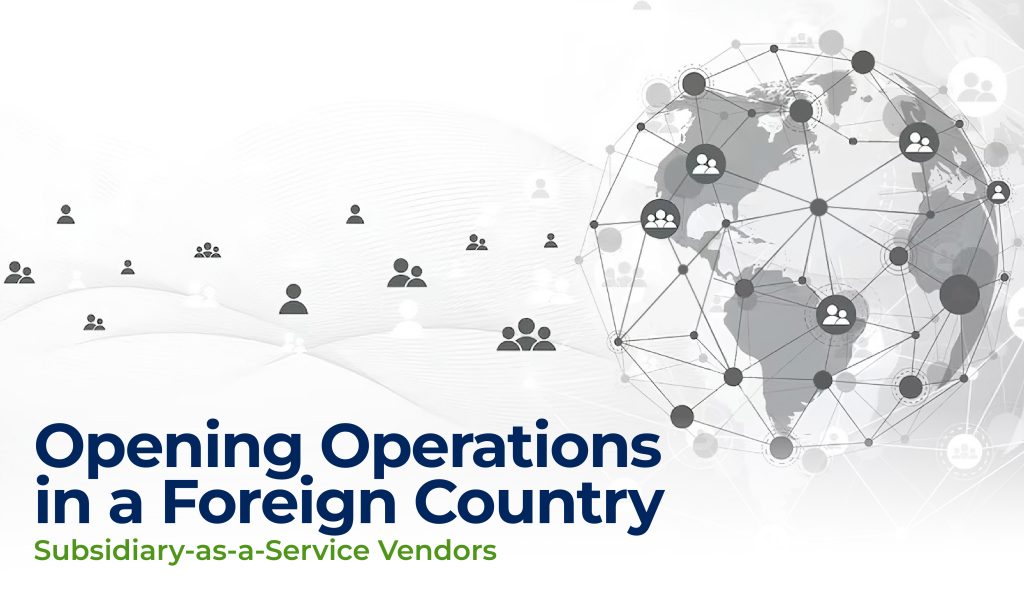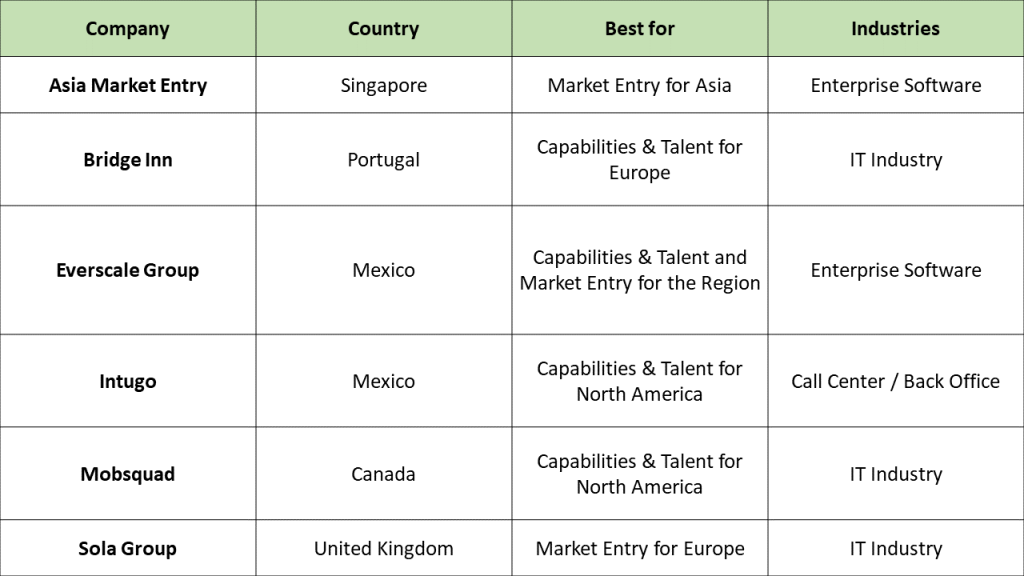
B2B Tech Companies have used different options like the Shelter model when starting operations in a foreign country. In particular, Subsidiary-as-a-Service is one of the preferred safe landing options because of its flexibility.
Similar to the as-a-Service model, it lowers greatly the cost and risks associated with running foreign operations. It also enables the option of running a pilot to test the region with temporary operations and scale accordingly.
What Tech Companies should expect from this type of service? Which vendors are available by country?
Challenges of opening foreign operations
Addressing the challenges associated with opening foreign operations is essential when considering international expansion. During their growth, IT Companies will evaluate the strategic option of opening a foreign operation, to access and support customers in a new market and/or to acquire talent that brings additional capabilities to the organization.
Establishing a foreign subsidiary could be daunting for small and midsize (SME) companies because of the resources and level of commitment required in an unknown region. Bigger corporations with greater financial resources have more options to consider, such as doing a Joint Venture to share risks or to gain already built capabilities by acquiring a local company.
Local Incorporation challenges for SME’s
- Level of Investment: Setup costs (advisory firms, government & local entities) and maintenance expenses of a fixed structure to support it.
- Potential risks: Submitting to foreign laws for the company, because of the conduct of a new business in the foreign country. Managing risks associated with legal, licensing, labor, trade, tax, and permits, including the learning curve of developing a local business.
- Managing Uncertainty: when to start, the right size of the operation, and local timelines.
- Right Team: Getting the local talent right from the start.
Post-pandemic, companies of all sizes have grown more comfortable in running foreign operations as there are more options, based on their commitment level and needs. Some start with different vendors at the same time (Employer of Record, Headhunting, Compliance Advisory Firm, etc) while others hire a sole vendor, like in the case of the shelter model, that can support them end-to-end, avoiding overhead costs. Market research shows that Safe landing options are more common in countries that are known for attracting foreign investment, with the added benefit that these vendors are specialized by industry.
The foreign company has the option of starting their foreign operation in the new country under a local company umbrella. This approach enables companies to start in a shorter time while saving costs by benefiting from their economies of scale and local know-how, sheltered from local risks. Depending on the industry and vendor, this can also be used as a strategy to pilot first the region, test assumptions, scale, and then do a full local incorporation.
Mexico: Case Study
Because of its privileged geographical location in the Americas, Mexico has plenty of available options. Foreigners open a business in Mexico to support North America or as the gateway to Latin America.
In Mexico the Manufacturing Industry has had for more than 30+ years the option of the Shelter Model, which enables foreign manufacturers to operate under an existing Mexican corporation, providing a “shelter” from legal and financial exposure. The Shelter model transfers to their customer their economies of scale benefit and takes the responsibility of Recruiting, HR & Payroll, Procurement, Facilities Management, Accounting & Finance, Gov’t Support & Compliance, and others.
Tech companies have been using this approach as well, by working with vendors that offer a similar framework but adapted to the higher flexibility required by the IT Industry and less dependent on infrastructure. This type of framework is known as a Subsidiary-as-a-Service (SUBaaS), Turnkey Subsidiary, or Virtual Foreign Subsidiary, as the operation is managed and owned by the foreign company, instead of the local company. Is crucial to not confuse it with subcontracting or outsourcing to a local tech company, which bills a percentage of its own team that will dedicated to a customer for a specific period.
The as-a-Service model is well known in the IT Industry, in which the customer only pays for what is used, benefiting from shared infrastructure. This approach brings down costs by using economies of scale and can be used in a shorter time. It adds flexibility and can scale when needed.

Subsidiary-as-a-Service Category
Salesforce launched its CRM Software-as-a-Service in a market that was dominated by legacy on-premise solutions that took months to implement, train, and adapt to the business. It was designed for small- to medium-sized companies that couldn’t afford traditional business software solutions and didn’t have the resources to support in-house the solution.
Salesforce enabled businesses to scale as needed, instead of being forced to purchase most of the capabilities upfront without knowing what level of usage they would actually need. SME companies could now start using the chosen capabilities from a menu in a matter of weeks—not months—while adding new functionalities as needed. It lowered the barrier to entry by eliminating the setup costs.
Subsidiary-as-a-Service, SUBaaS, similar to the shelter model includes the option of being safeguarded from local risks, incorporating when needed.
With SUBaaS, companies pay a monthly fee (per user) for the services they use—no more, no less. Most notably, Subsidiary-as-a-Service (SUBaaS) provides full foreign subsidiary capabilities for operations and local presence.
What Subsidiary-as-a-Service Solves
Certain tech companies may be aware of the potential advantages and new revenue opportunities that can arise from establishing a presence in a different country. However, they may choose to delay this strategic move until it becomes an imperative, driven by the complexities associated with foreign expansion.
Setting up a foreign office demands a substantial allocation of resources and time, the precise magnitude of which remains subject to estimation. Additionally, the crucial tasks of identifying and hiring the right personnel on the initial attempt and navigating unfamiliar local laws beyond their borders require meticulous consideration.
The Subsidiary as a Service framework lowers substantially the entry cost and associated risks of entering a new region. But also, companies can start before to test their assumptions and scale when ready. It can start small or big operations, temporary or permanent, using the framework.
Different configurations can be built depending on the level of commitment the foreign company is ready to make: a temporary project team, a small sales team for market entry, a large Center of Excellence and many more.
Because of multiple safe landing vendors, SUBaaS specialize to serve better and differentiate their value proposition by including local and industry-specific know-how.
The SUBaaS vendor saves time and spending additional resources for learning local practices. For local operations, this could mean efficient procurement spending, setting up employee’s benefits packages according to location and market, best facilities location, relocation processes, partnerships already established with local universities and so on.
Moreover, it is customary for the vendor to specialize in a specific sector, with the most prevalent industries being Manufacturing, Call Centers/BPO, and Technology. Not only the foreign customer will not need to train them on their industry, but the vendor will give early feedback on the customer’s overall business strategy and provide insights into the finer aspects of building effective business practices.
The vendors that provide the highest added value are those who can make their customers feel as though they have acquired the capabilities and industry-specific expertise of a local company (minus the installed customer base).
Benefits To Be Expected
In summary, you can count on that leveraging the Subsidiary as a Service model will help the organization on multiple fronts:
- Start benefiting from the foreign operation in days instead of months, with faster scaling capabilities.
- Avoiding high setup and unnecessary costs.
- Minimize greatly the risk, while still owning the operation by a USA contract.
- Because of the built-in industry local best practices from the SUBaaS, additional savings can be expected and a higher success rate of local strategies.
- No need to start big. If needed, being able to pilot the region before a full deployment. Confirm potential customers that the organization can support them in the new country if required, with the SUBaaS ready to be turned on.
Each is a great benefit, but all of them together, is what makes a SUBaaS approach the logical choice.
What Capabilities Vendors Need To Have
When doing Market Research when evaluating SUBaaS vendors, several items need to be checked so they can offer end-to-end capabilities in the industry they specialize.
Capabilities required:
Local end-to-end infrastructure and resources
The as-a-Service model relies on benefiting from economies of scale, having the assets. Having a customer portal with a great interface is just that, a nice interface. Being able to run Payroll is just one feature of multiple roles a local operation has. Be careful with companies that promote how they have multiple partnerships to be able to deliver locally.
Plenty of Years in the Market
The foreign customer benefits from avoiding the learning curve, so the Subsidiary-as-a-Service (SUBaaS) should have checked already this item on their own.
Industry Capabilities
While achieving savings and minimizing risks are undoubtedly crucial factors, the ultimate determinant of the move’s success lies in effectively establishing a thriving presence in the new region. The vendor’s ability to provide expert industry-specific local know-how will play a pivotal role in accomplishing this objective.
Example of Subsidiary-as-a-Service (SUBAAS) Vendors
The location of the vendor will significantly impact their value proposition, as certain countries serve as prominent entry points for the region, while others may offer access to talent and capabilities at more competitive costs, and some may provide both advantages.




